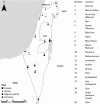Francisella-Like Endosymbionts and Rickettsia Species in Local and Imported Hyalomma Ticks
- PMID: 28710265
- PMCID: PMC5583492
- DOI: 10.1128/AEM.01302-17
Francisella-Like Endosymbionts and Rickettsia Species in Local and Imported Hyalomma Ticks
Abstract
Hyalomma ticks (Acari: Ixodidae) are hosts for Francisella-like endosymbionts (FLE) and may serve as vectors of zoonotic disease agents. This study aimed to provide an initial characterization of the interaction between Hyalomma and FLE and to determine the prevalence of pathogenic Rickettsia in these ticks. Hyalomma marginatum, Hyalomma rufipes, Hyalommadromedarii, Hyalommaaegyptium, and Hyalommaexcavatum ticks, identified morphologically and molecularly, were collected from different hosts and locations representing the distribution of the genus Hyalomma in Israel, as well as from migratory birds. A high prevalence of FLE was found in all Hyalomma species (90.6%), as well as efficient maternal transmission of FLE (91.8%), and the localization of FLE in Malpighian tubules, ovaries, and salivary glands in H. marginatum Furthermore, we demonstrated strong cophylogeny between FLE and their host species. Contrary to FLE, the prevalence of Rickettsia ranged from 2.4% to 81.3% and was significantly different between Hyalomma species, with a higher prevalence in ticks collected from migratory birds. Using ompA gene sequences, most of the Rickettsia spp. were similar to Rickettsiaaeschlimannii, while a few were similar to Rickettsiaafricae of the spotted fever group (SFG). Given their zoonotic importance, 249 ticks were tested for Crimean Congo hemorrhagic fever virus infection, and all were negative. The results imply that Hyalomma and FLE have obligatory symbiotic interactions, indicating a potential SFG Rickettsia zoonosis risk. A further understanding of the possible influence of FLE on Hyalomma development, as well as on its infection with Rickettsia pathogens, may lead to novel ways to control tick-borne zoonoses.IMPORTANCE This study shows that Francisella-like endosymbionts were ubiquitous in Hyalomma, were maternally transmitted, and cospeciated with their hosts. These findings imply that the interaction between FLE and Hyalomma is of an obligatory nature. It provides an example of an integrative taxonomy approach to simply differentiate among species infesting the same host and to identify nymphal and larval stages to be used in further studies. In addition, it shows the potential of imported Hyalomma ticks to serve as a vector for spotted fever group rickettsiae. The information gathered in this study can be further implemented in the development of symbiont-based disease control strategies for the benefit of human health.
Keywords: Francisella; Rickettsia; arthropod symbiosis; vector-borne diseases.
Copyright © 2017 American Society for Microbiology.
Figures





References
-
- Apanaskevich DA, Horak IG. 2008. The genus Hyalomma Koch, 1844: v. re-evaluation of the taxonomic rank of taxa comprising the H. (Euhyalomma) marginatum Koch complex of species (Acari: Ixodidae) with redescription of all parasitic stages and notes on biology. Int J Acarol 34:13–42. doi:10.1080/01647950808683704. - DOI
-
- Ioannou I, Chochlakis D, Kasinis N, Anayiotos P, Lyssandrou A, Papadopoulos B, Tselentis Y, Psaroulaki A. 2009. Carriage of Rickettsia spp., Coxiella burnetii and Anaplasma spp. by endemic and migratory wild birds and their ectoparasites in Cyprus. Clin Microbiol Infect 15(Suppl 2):S158–S160. doi:10.1111/j.1469-0691.2008.02207.x. - DOI - PubMed
Publication types
MeSH terms
LinkOut - more resources
Full Text Sources
Other Literature Sources
Medical
Molecular Biology Databases
Miscellaneous

